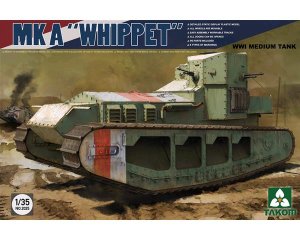

Ref.: TAKO-2025

Medium Tank Mk A Whippet The Medium Mark A "Whippet" was a British tank of the First World War. It was intended to complement the slower British heavy tanks by using its relative mobility and speed in exploiting any break in the enemy lines. Whippets later took part in several of the British Army’s postwar actions, notably in Ireland, North Russia and Manchuria. The Whippet was first produced in 1917. On 3 October 1916 William Tritton, about to be knighted for developing the Mark I, proposed to the Tank Supply Department that a faster and cheaper tank, equipped with two engines like the Flying Elephant, should be built to exploit gaps that the heavier but slow tanks made, an idea that up till then had been largely neglected. This was accepted on 10 November and approved by the War Office on 25 November. At that time the name for the project was the Tritton Chaser. Traditionally the name Whippet is attributed to Sir William himself. Actual construction started on 21 December. The first prototype, with a revolving turret taken from an Austin armoured car — the first for a British tank design, as Little Willie’s original turret was not yet revolving — was ready on 3 February 1917 and participated (probably without one) in the famous "tank trials day" at Oldbury on 3 March. The next day, in a meeting with the French to coordinate allied tank production, the Commander-in-Chief of the British forces Field Marshal Haig ordered the manufacture of two hundred vehicles, the first to be ready on 31 July. Although he was acting beyond his authority, as usual, his decisions were confirmed in June 1917. The first production tanks left the factory in October and two were delivered to the first unit to use them, F Battalion of the Tank Corps (later 6th Battalion), on 14 December 1917. In December 1917 the order was increased from 200 to 385 but this was later cancelled in favour of more advanced designs. Armament was four 0.303 in Hotchkiss Mk 1 machine guns, one covering each direction. As there were only three crewmen, the gunner had to jump around a lot, though often assisted by the commander. Sometimes a second gunner was carried in the limited space, and often a machine gun was removed to give more room, as the machine guns could be moved from one mounting position to another to cover all sides.